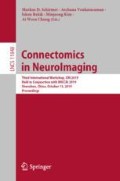Abstract
Early diagnosis of neurological diseases such as Alzheimer’s disease (AD) is extremely vital for patient treatment. Analyzing the human brain connectivity is a popular approach in investigating the relationship between the brain morphology, structure, and function and the emergence of neurological diseases. However, extracting relevant diagnostic information from the connectome is still one of the most challenging problems. Many works have thoroughly studied the connectional map of the brain, however, to the best of our knowledge, no previous study had used graph morphology to rigorously explore the topological properties of the human connectome. In this paper, we propose a novel graph morphology-based genetic algorithm (GMGA) to mine the brain network and extract the most relevant connections for disordered brain state stratification. First, we define our graph morphological structural operators (SE) and design a subgraph matching technique for matching a particular graph-based SE with an input brain connectome. Second, we propose GMGA which identifies the optimal sequence of morphological operations using a predefined structural element for distinguishing between two brain states (e.g., late mild cognitive impairment (LMCI) vs Alzheimer’s disease (AD)). Last, we train a linear classifier in a K-fold cross-validation fashion using the morphed brain graphs given the optimal learned morphological operator sequence. Our experimental results demonstrate a significant gain in classification performance between LMCI and AD groups in comparison with baseline methods. This work constitutes the first proof-of-concept of the merit of graph morphology in decoding the healthy and disorder brain connectomes.
Access this chapter
Tax calculation will be finalised at checkout
Purchases are for personal use only
References
Bullmore, E., Bassett, D.: Brain graphs: graphical models of the human brain connectome. Annu. Rev. Clin. Psychol. 7, 113–140 (2011)
Bullmore, E., Sporns, O.: Complex brain networks: graph theoretical analysis of structural and functional systems. Nat. Neurosci. 10, 186–198 (2009)
Cousty, J., Najman, L., Serra, J.: Some morphological operators in graph spaces. In: Wilkinson, M.H.F., Roerdink, J.B.T.M. (eds.) ISMM 2009. LNCS, vol. 5720, pp. 149–160. Springer, Heidelberg (2009). https://doi.org/10.1007/978-3-642-03613-2_14
Dhifallah, S., Rekik, I., Alzheimer’s Disease Neuroimaging Initiative, et al.: Clustering-based multi-view network fusion for estimating brain network atlases of healthy and disordered populations. J. Neurosci. Methods 311, 426–435 (2019)
Heijmans, H., Nacken, P., Toet, A., Vincent, L.: Graph morphology. J. Vis. Commun. Image Represent. 24–38 (1990)
Heijmans, H., Vincenty, L.: Graph morphology in image analysis. Math. Morphol. Image Process. 34, 171–203 (1992)
Holland, J.H.: Genetic algorithms. Sci. Am. 267(1), 66–72 (1992)
Liu, F., et al.: Multivariate classification of social anxiety disorder using whole brain functional connectivity. Brain Struct. Funct. 220, 101–115 (2015)
Mahjoub, I., Mahjoub, M.A., Rekik, I.: Brain multiplexes reveal morphological connectional biomarkers fingerprinting late brain dementia states. Sci. Rep. 8(1), 4103 (2018)
Nebli, A., Rekik, I.: Gender differences in cortical morphological networks. Brain Imaging Behav. 1–9 (2019)
Richiardi, J., Ville, D.V.D., Riesen, K., Bunke, H.: Vector space embedding of undirected graphs with fixed-cardinality vertex sequences for classification. In: 20th International Conference on Pattern Recognition, pp. 902–905 (2010)
Soussia, M., Rekik, I.: Unsupervised manifold learning using high-order morphological brain networks derived from T1-w MRI for autism diagnosis. Front. Neuroinform. 12 (2018)
Sporns, O.: The human connectome: a complex network. Ann. N.Y. Acad. Sci. 1224, 109–125 (2011)
Tijms, B., et al.: Alzheimer’s disease: connecting findings from graph theoretical studies of brain networks. Neurobiol. Aging 34, 2023–2036 (2013)
Vincent, L.: Graphs and mathematical morphology. Signal Process. 16, 365–388 (1989)
Yu, R., Qiao, L., Chen, M., Lee, S.W., Fei, X., Shen, D.: Weighted graph regularized sparse brain network construction for MCI identification. Pattern Recogn. 90, 220–231 (2019)
Author information
Authors and Affiliations
Corresponding author
Editor information
Editors and Affiliations
Rights and permissions
Copyright information
© 2019 Springer Nature Switzerland AG
About this paper
Cite this paper
Ben Khelifa, O., Rekik, I. (2019). Graph Morphology-Based Genetic Algorithm for Classifying Late Dementia States. In: Schirmer, M., Venkataraman, A., Rekik, I., Kim, M., Chung, A. (eds) Connectomics in NeuroImaging. CNI 2019. Lecture Notes in Computer Science(), vol 11848. Springer, Cham. https://doi.org/10.1007/978-3-030-32391-2_3
Download citation
DOI: https://doi.org/10.1007/978-3-030-32391-2_3
Published:
Publisher Name: Springer, Cham
Print ISBN: 978-3-030-32390-5
Online ISBN: 978-3-030-32391-2
eBook Packages: Computer ScienceComputer Science (R0)


